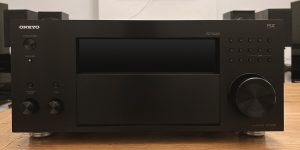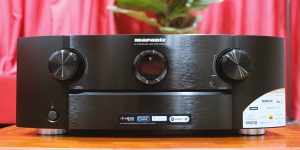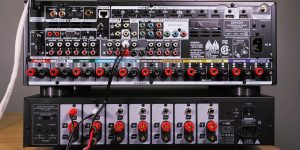Today there is a relatively wide range of different models on the receiver market, as well as serious rivalry among manufacturers. Many companies offer their products with a different set of functions and features. Marantz, Denon, and Yamaha are among the most famous. Here I have selected the best Marantz receivers that I tested myself.
Marantz has been producing audio equipment since 1953 and is currently one of the leaders in the industry. This Japanese company offers budget models, mid-range and premium options. Thus, you can find a device for every taste among the presented models.
I have prepared Marantz AV receiver reviews where I will tell you about their features, advantages, and disadvantages. The purpose of this article is to help you make the right choice. So, let’s not waste a minute. Just keep reading.

Marantz receivers comparison table
| Name | Channels | Power output | HDMI in/out | Bluetooth/Wi-Fi | Review |
|---|---|---|---|---|---|
| Marantz Cinema 50 best overall | 9.4 | 110W/8 Ohm, 150W/6 Ohm | 6/2 | yes/yes | Review |
| Marantz SR5015 mid-priced pick | 7.2 | 100W/8 Ohm, 180W/6 Ohm | 6/2 | yes/yes | Review |
| Marantz NR1510 budget choice | 5.2 | 50W/8 Ohm, 60W/6 Ohm | 6/1 | yes/yes | Review |
| Marantz SR8015 premium | 11.2 | 140W/8 Ohm, 205W/6 Ohm | 8/3 | yes/yes | Review |
| Marantz NR1200 stereo | 2.0 | 75W/8 Ohm, 100W/6 Ohm | 5/1 | yes/yes | Review |
Best Marantz AV receiver reviews
Marantz Cinema 50 – best overall

Yes, I’m a conservative and don’t like to change traditions. So, as usual, I will start my review with a clear leader. This 9.4 channel receiver is a bright representative of the CINEMA lineup, which was released in 2022. As you may have guessed (given its name), it is ideal for watching movies.
First of all, I noticed the minimalistic design of this model, with a round LCD screen. It looks like a device from an alien spaceship. Yes, this type of screen is unusual, but in my opinion, it is less informative than the traditional one. The main control buttons are hidden under a metal cover, protecting them from dust and curious small children. Available in black and silver-gold color, which I really liked.

The Marantz CINEMA 50 delivers 110 watts (8 ohms, 20Hz-20kHz, 0.08%, 2ch) and guarantees excellent sound quality even in spacious living rooms. All ports (6/3 HDMI) of this model support 8K video, 1080P/4K upscaling to 8K, CEC, HDCP 2.3, and ARC/eARC functions. And since it is oriented on video content, of course, it supports HDR, HLG, Dolby Vision, HDR10+, and Dynamic HDR with contrast enhancement. In short, buy it, sit back in your favorite chair, and don’t forget the popcorn.
Its wireless features include extensive compatibility with streaming services and voice assistants, HEOS, and 2-zone audio streaming. By the way, I was pleasantly surprised by the quality of the streaming music. The warmth that is a trademark of Marantz plays with an incredible spectrum of colors.
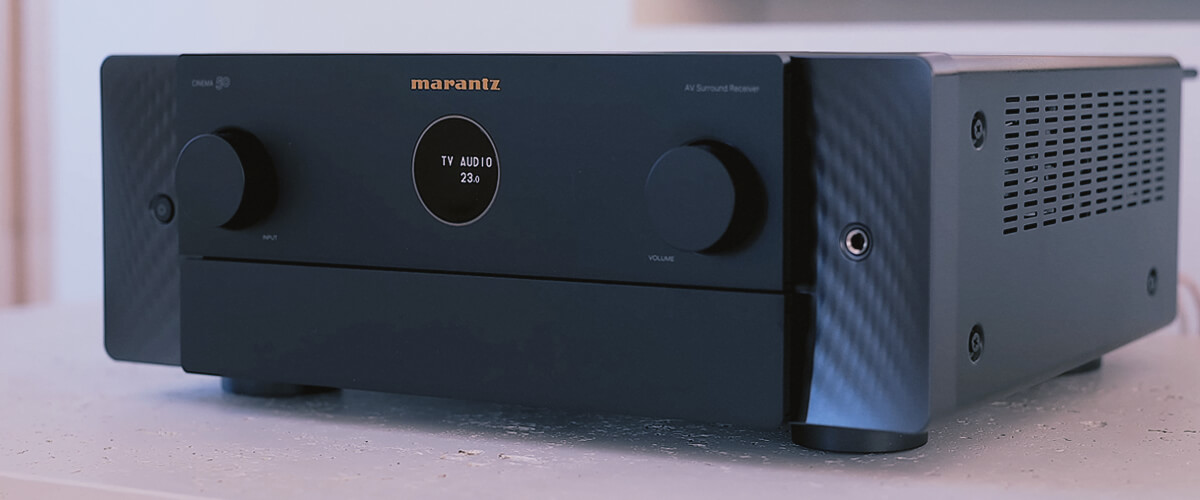
One of the innovative technologies used by the manufacturer in CINEMA 50 is HDAM (Hyper Dynamic Amplifier Module) and current feedback topology. These have a major impact on sound processing, providing greater detail and low phase shift. That’s why this receiver sounds great in surround and stereo sound.
If we’re talking about surround sound, let me tell you that CINEMA 50 supports DTS:X (DTS Neural:X, DTS Virtual:X), Dolby Atmos (Dolby Atmos Height Virtualization, Dolby Atmos Music), IMAX Enhanced, Auro-3D, and 360 Reality Audio. As they say, it’s “fully loaded”!
Overall, I am ready to say that this receiver sounds fantastic! It is the best Marantz receiver on my list in terms of features, performance, and sound. Perfect for movie and music fans.
Key specs
- Channels: 9.4.
- Power output: 110W/8 Ohm, 150W/6 Ohm.
- HDMI inputs/outputs: 6/2.
- Video functions: 8K/60Hz, 4K/60Hz, 4K/120Hz, HDMI upscaling up to 8K.
- Bluetooth/Wi-Fi: yes/yes.
- Streaming services: AirPlay 2, Spotify, TuneIn, Deezer, Tidal, Netflix, Amazon Prime.
- Supports: HDMI ARC, HDMI eARC, HDMI CEC, HDCP2.3, HDR10+, Dolby Vision.
- Surround sound: DTS HD Master, DTS:X, DTS Neural:X, DTS Virtual:X, Dolby Atmos, Dolby TrueHD, Dolby Height Virtualization, Dolby Surround, MAX Enhanced, Auro-3D, 360 Reality Audio, MPEG H.
Pros
- Availability of innovative technologies such as HDAM and current feedback topology.
- Full support for modern surround sound formats.
- Incredible quality in surround and stereo sound.
- Specialized focus on video content.
- Availability of Audyssey MultEQ XT32 and Dirac Live.
Cons
- Inexperienced users will have to spend time on customization.
Marantz SR5015 – mid-priced pick

My next choice is Marantz SR5015. This receiver has a 7.2 channel amplifier with 100W per channel (8 ohms, 20Hz – 20kHz, 0.08%), supports two multi-room zones, and has enough power for building a quality multimedia system.
As for the picture, the Marantz AVR receiver supports 8K at 60Hz and 4K at 120Hz pass-through. The model is equipped with HDR, HLG, HDR10+, Dolby Vision, Dynamic HDR, VRR, and ALLM. At the end of the test, I concluded that the image quality of this model and the AVR SR6015 is almost at the same level. I have to say that the SR5015 doesn’t have IMAX Enhanced, but all in all, it looks very tasty.

There is support for Lossy and Lossless formats. Also, I calibrated the receiver quite quickly with Audyssey MultEQ XT technology. So,I suppose you won’t have any problems with the setting.
Now, let’s focus on the connectors and connections. The AVR has 6 HDMI inputs (2.1) and 2 HDMI outputs (eARC) with HDCP 2.3 support. Also, you can use such connection methods as subwoofer out (2 points), Bluetooth, Ethernet Ports, and Wi-Fi.

The sound quality pleasantly surprised me. This device supports modern surround sound audio formats, such as DTS:X, Dolby Atmos, Dolby Atmos Height Virtualization Technology, and DTS Virtual: X. Considering the fact that I did a little testing without in-ceiling speakers, I managed to get a pretty good result. Even at a high volume level, the generated sound is natural. By the way, I did the sound tuning with Audyssey MultEQ XT.
If you compare the Marantz SR5015 to the SR6015, it is almost one and a half times cheaper. Unfortunately, there is no support for IMAX Enhanced. Also, the model has a little less power and connectors. But the rest of the functionality is almost the same.
This model is a great option that is easy to install and configure. Moreover, it gives good sound and picture quality. Yes, it is no conjurer, but Marantz SR5015 solves its problems perfectly.
Key specs
- Channels: 7.2.
- Power output: 100W/8 Ohm, 180W/6 Ohm.
- HDMI inputs/outputs: 6/2.
- Video functions: 8K/60Hz, 4K/120Hz, 4K/60Hz.
- Bluetooth/Wi-Fi: yes/yes.
- Streaming services: AirPlay 2, Pandora, Spotify, Napster, SiriusXM, TIDAL, Deezer, Qobuz, Amazon Music.
- Suppots: HDMI eARC, HDMI Upscaling up to 4K, Dolby Vision, HDR 10+.
- Surround sound: Dolby Atmos, Dolby Atmos Height Virtualization, Dolby TrueHD, Dolby Surround, DTS:X, Multichannel Stereo.
Pros
- Advanced 8K pass-through.
- Full 3D sound support.
- All 6 HDMI inputs are version 2.1.
- Two multi-room zones are present.
Cons
- IMAX Enhanced is not available.
- The insufficient number of HDMI outputs.
Marantz NR1510 – budget choice

The Marantz NR1510 receiver is next on my list. Even though this model was released in 2019, it is still relevant and quite interesting, especially if you have a limited budget.
The receiver has a 5.2 channel amplifier with about 50W per channel (8 ohms, 20Hz – 20kHz, 0.08%). As for the multi-room zones function, you won’t find it here because it is a budget model. But HEOS Built-in multi-room streaming and AirPlay 2 will make listening to music in different rooms of the house a pleasant experience for you.
The AVR supports 4K UHD resolution at 60Hz. There are also such technologies as HDR10, HLG, and Dolby Vision. The picture looks good, but I can’t say anything special about it.
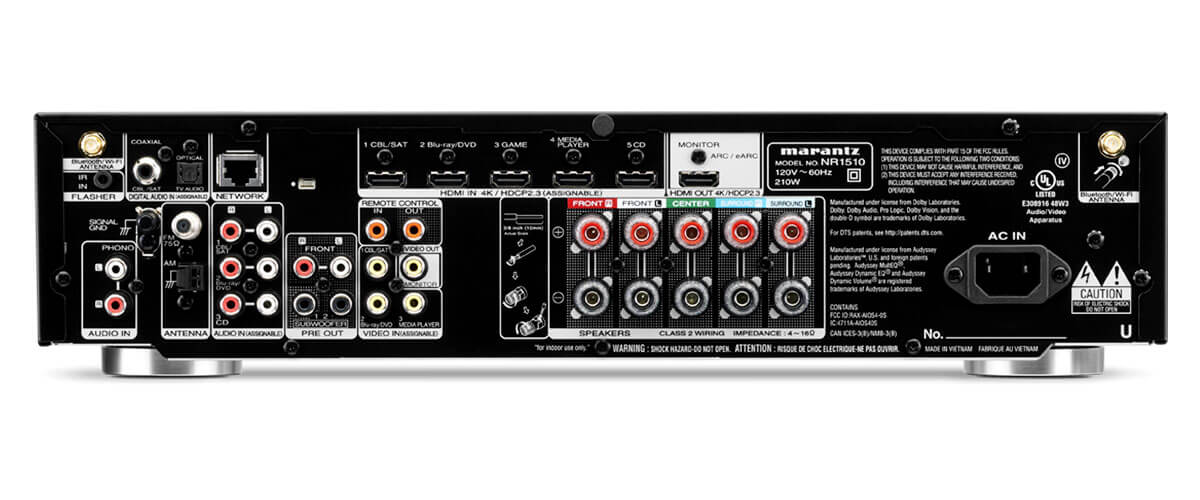
The device quickly processes and decodes different formats, including Lossy and Lossless. If you need to calibrate the sound, Audyssey MultEQ can help.
As for connectors and connections, the receiver has 6 HDMI inputs (2.0/eARC) and 1 HDMI output (2.0) with HDCP 2.3 support. In addition, you can connect to the device via Bluetooth, Ethernet Ports, Wi-Fi, and 2 subwoofers. Also, I was pleasantly surprised with the present Phono (MM) In. With its help, you will be able to listen to vinyl records.
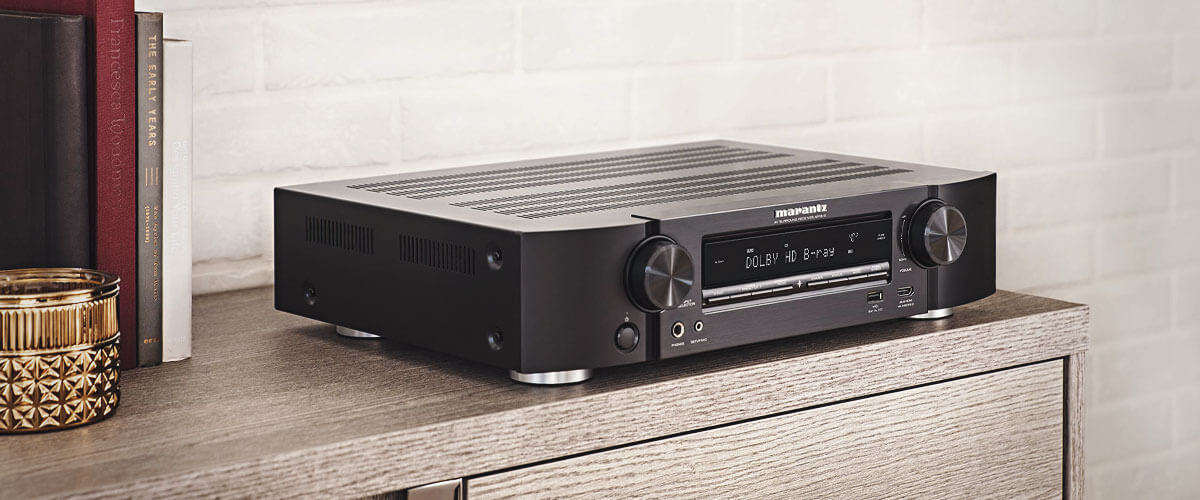
The music playback is quite clear. I noticed no bugs or malfunctions during the test. All in all, the sound is okay, considering the features and price of the receiver. But I would like to point out one significant disadvantage. The device does not support surround sound.
The Marantz NR1510 receiver is inferior to the NR1711. The rival has more dynamic and alive sound, as it supports all modern surround sound formats. Also multi-room zones, 8K pass-through support, and HDR10+ technology are absent.
In short, the AV receiver NR1510 is a budget variant with limited functionality. Such a choice is more suitable for beginners and small rooms.
Key specs
- Channels: 5.2.
- Power output: 50W/8 Ohm, 60W/6 Ohm.
- HDMI inputs/outputs: 6/1.
- Video functions: 4K/60Hz.
- Bluetooth/Wi-Fi: yes/yes.
- Streaming services: AirPlay 2, Pandora, Spotify, Napster, SiriusXM, TIDAL, Deezer, Qobuz, Amazon Music.
- Suppots: HDMI eARC, Dolby Vision, HDR 10.
- Surround sound: Dolby TrueHD, DTS HD Master, Multichannel Stereo.
Pros
- 4K Ultra HD.
- Compact and slim chassis.
- Phono (MM) In support.
- There are 2 subwoofers out.
Cons
- Only one HDMI output.
- HDMI inputs/output version 2.0.
- No surround sound technology.
Marantz SR8015 – premium
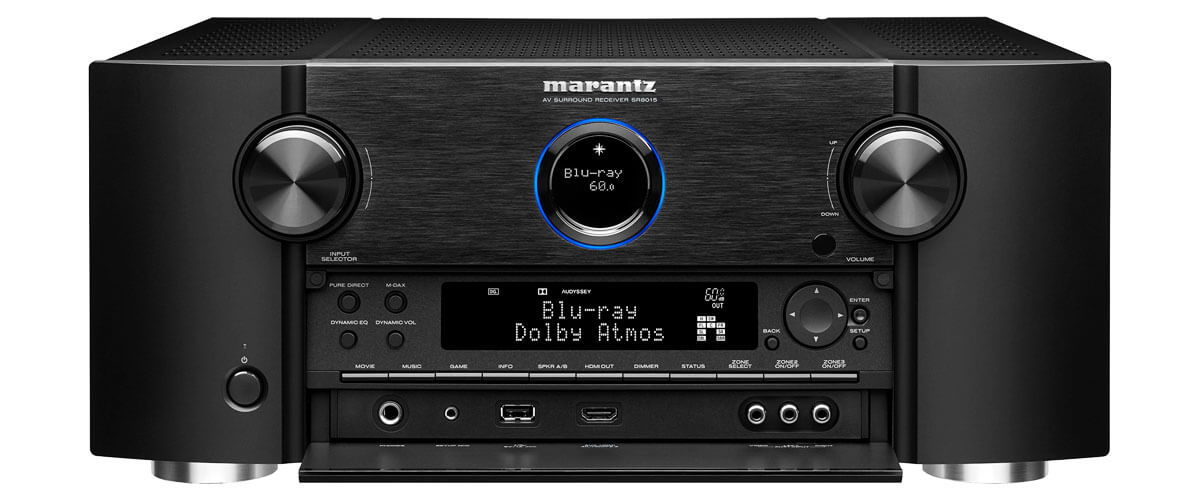
A monster like Marantz SR8015 has almost everything that true fans of quality sound could desire. But do not forget that you have to pay for all this functionality. Still, first things first.
The SR8015 receiver has an 11.2 channel amplifier with more than 140W of power per channel (8 Ohms, 20Hz-20kHz, THD: 0.05%, 2ch driven). Of course, this model has multi-room zones. In our case, there are three points. So, even big families will be able to watch movies or listen to music independently of each other.
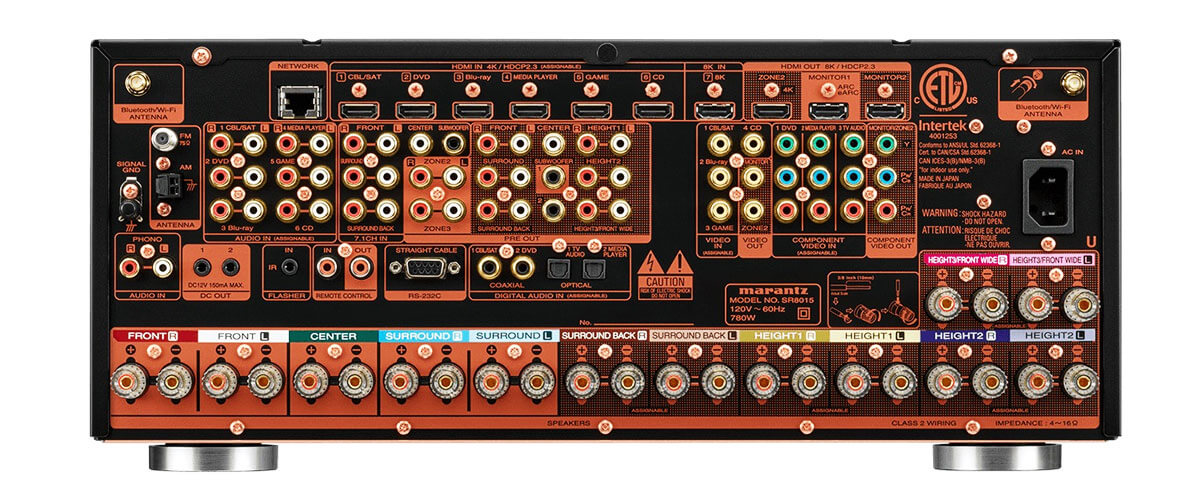
When it comes to the picture, I can say it looks fantastic. Thanks to the support of 8K resolution at 60Hz, you get an incredibly high-quality, pleasant image. There is also a 4K pass-through at 120Hz. In addition, the receiver supports HDR10+, Dynamic HDR, ALLM, VRR, QFT (Quick Flame Transport), and QMS (Quick Media Switching). And the presence of IMAX Enhanced adds even more vivid colors to this palette.
And, of course, I have few words about the connectors and the different ways of connecting. The AVR has 7 HDMI inputs (2.1)/1 HDMI input (2.1) on the back and front, as well as 3 HDMI outputs (1 HDMI eARC) with HDCP 2.3 support. Available connection methods include two independent subwoofer outs, Wi-Fi, Bluetooth, and Ethernet Ports. The Phono (MM) In is a great find for those who like listening to vinyl records.
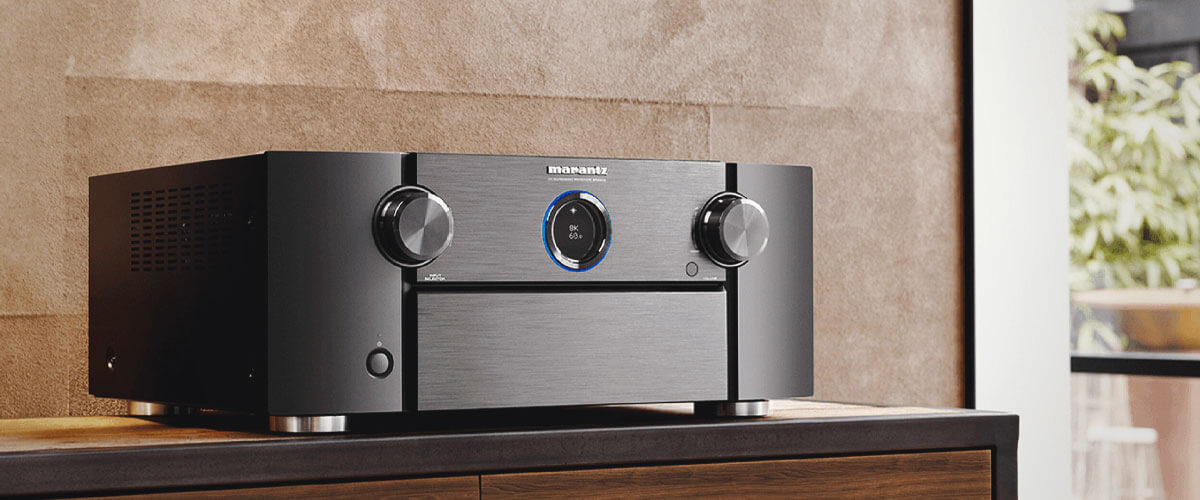
As expected, the Marantz flagship receiver sounds on an unimaginable level. Music and movie playback is crystal clear, and the surround sound gave me a special feeling. Here you will find full 3D audio support. I especially want to highlight the presence of DTS:X Pro and Auro-3D. With their help, you can achieve incredible results.
Ultimately, I would like to summarize that this model has a lot to offer, even to the sophisticated multimedia connoisseur. Starting with a powerful 11.2 channel amplifier, advanced 8K pass-through, and ending with support for all modern video and audio formats, including surround sound. Therefore, if you are a connoisseur of quality sound and good image quality, and most importantly – you are not strapped for cash, this is your favorite.
Key specs
- Channels: 11.2.
- Power output: 140W/8 Ohm, 205W/6 Ohm.
- HDMI inputs/outputs: 8/3.
- Video functions: 8K/60Hz, 4K/120Hz, 4K/60Hz.
- Bluetooth/Wi-Fi: yes/yes.
- Streaming services: AirPlay 2, Pandora, Spotify, Napster, SiriusXM, TIDAL, Deezer, Qobuz, Amazon Music.
- Suppots: HDMI eARC, HDMI Upscaling up to 8K, Dolby Vision, HDR 10+.
- Surround sound: Dolby Atmos, Dolby Atmos Height Virtualization, Dolby TrueHD, Dolby Surround, DTS:X Pro, DTS Virtual:X, DTS HD Master, DTS Neural:X, Multichannel Stereo, IMAX Enhanced, Auro 3D.
Pros
- The front side of the AVR is metal.
- Advanced 8K resolution.
- Three multi-room zones.
- IMAX Enhanced is available.
- All 11 HDMI ports are version 2.1.
- DTS:X Pro and Auro-3D are present.
Cons
- I haven’t found any disadvantages.
Marantz NR1200 – stereo
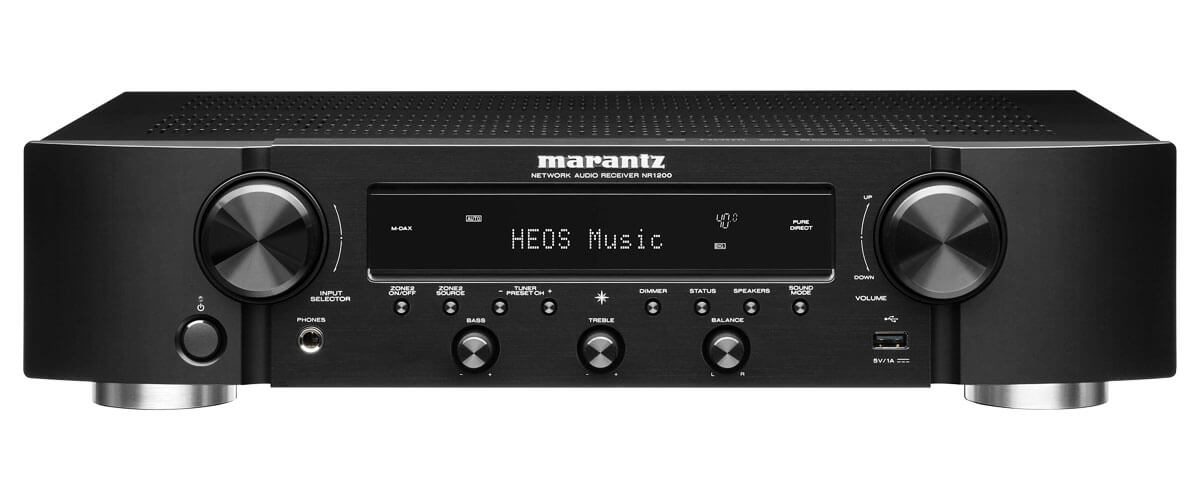
If your main goal is simply listening to high-quality music, then NR1200 is a suitable model for you. And now, I will tell you in more detail why I included this particular model in my review.
The Marantz stereo receiver has a 2-channel amplifier with approximately 75W per channel (8 ohms, 20Hz – 20kHz, 0.08%). Here you will not find any multi-room zones since this is a stereo receiver. Although I must say, some stereo models support this feature.
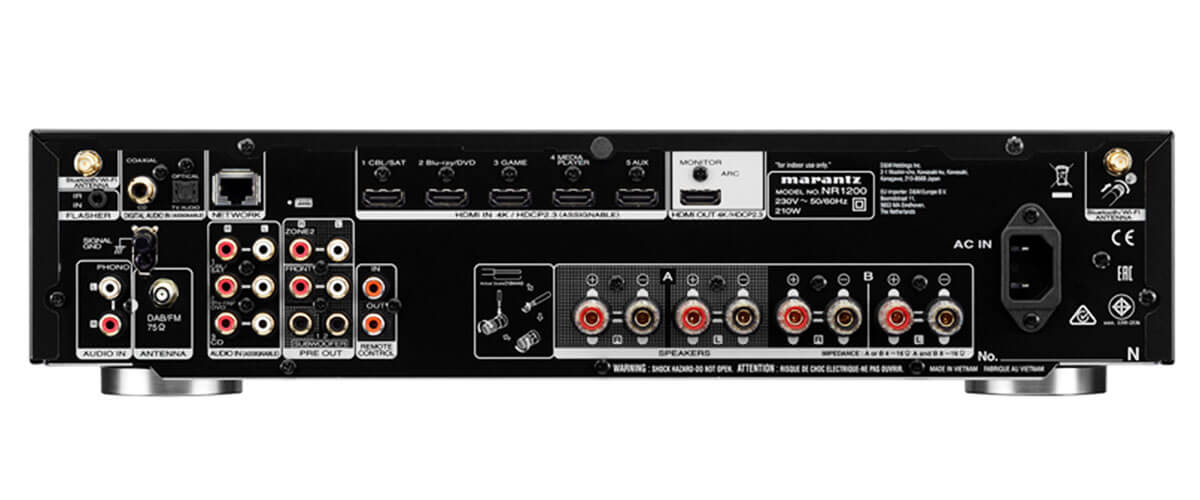
Even though this device is more focused on playing music, you can still watch high-quality movies. This capability is provided by support for 4K/60Hz with 4:4:4 resolution and HDCP 2.3. Also, such technologies as Dolby Vision, HDR10, and HLG are available.
The Marantz NR1200 has 5 HDMI inputs (2.0) and 1 HDMI output (2.0) with eARC support. In addition, you can take advantage of 2 subwoofer outs, Wi-Fi, Ethernet Ports, Bluetooth and Phono (MM).
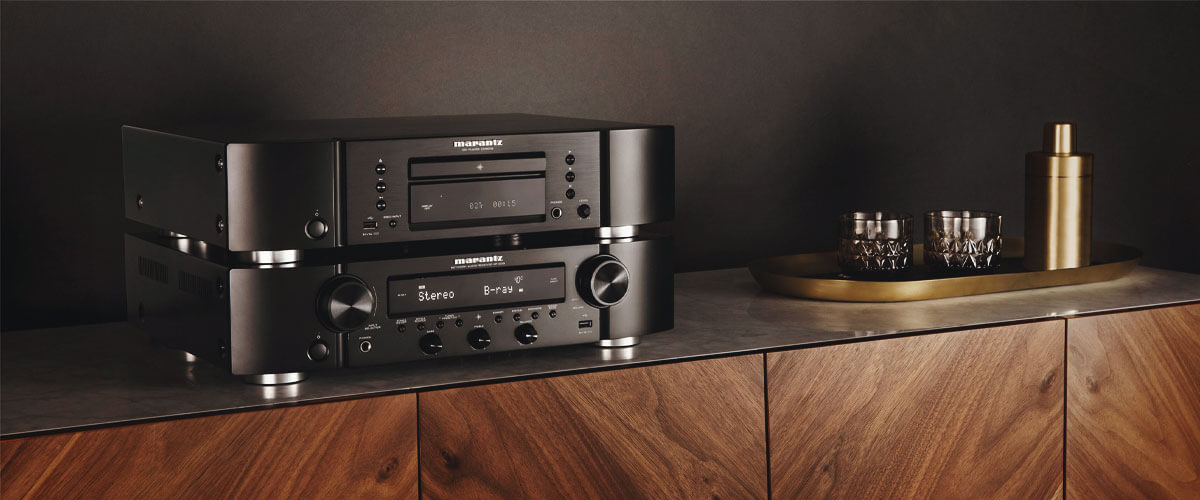
The main advantage of the receiver is its sound. It is clean, pleasant, and quite detailed. Of course, this model does not have the ability to playback Dolby Atmos, DTS:X or Dolby Surround responsible for surround sound. Therefore, the NR1200 is more suitable for those who prefer listening to analog/digital music or radio. Mind that there is no Audyssey sound calibration.
To summarize, I can say that this model does an excellent job with its main task, supports many audio formats, and 4K pass-through with eARC. For a stereo receiver, this is more than enough.
Key specs
- Channels: 2.0.
- Power output: 75W/8 Ohm, 100W/6 Ohm.
- HDMI inputs/outputs: 5/1.
- Video functions: 4K/60Hz.
- Bluetooth/Wi-Fi: yes/yes.
- Streaming services: AirPlay 2, Pandora, Spotify, Napster, SiriusXM, TIDAL, Deezer, Qobuz, Amazon Music.
- Suppots: HDMI eARC, HDR 10.
Pros
- Slim chassis.
- There is a 4K resolution.
- It supports many audio formats.
- Phono (MM) In is available.
Cons
- All HDMI ports version 2.0.
- Only 1 HDMI output.
- No multi-room zones.
- No Audyssey sound calibration technology.
Marantz NR1711

The Marantz NR1711 is my last choice. But definitely not the last in its capabilities. Let’s see why I included this receiver on my list.
This slim model has a 7.2-channel amplifier with 50 watts per channel (8 ohms, 20Hz – 20kHz, 0.08% THD, 2ch. drive) and equipped with two multi-room zones that can be controlled via the app.
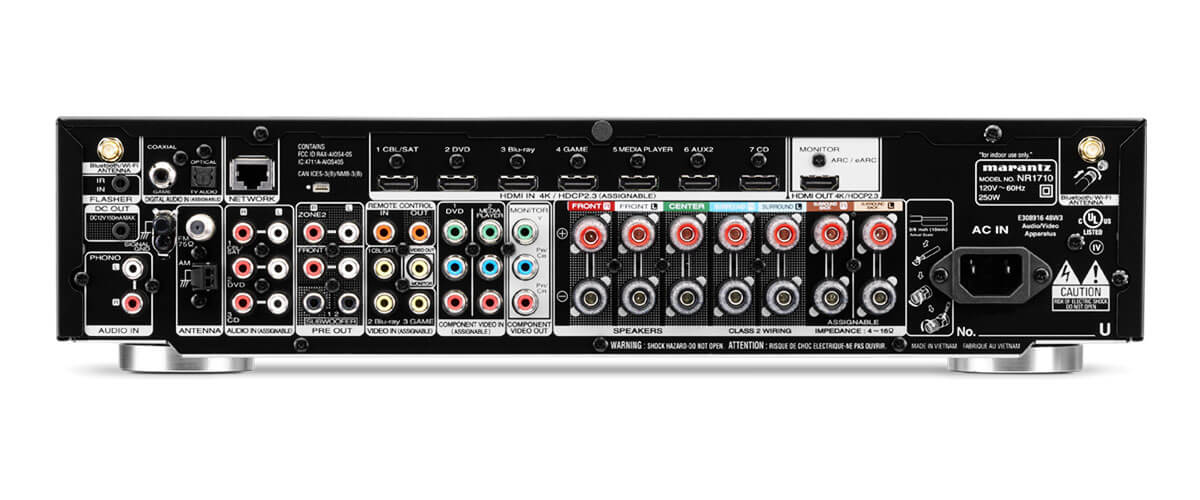
Now, as for the picture. You can enjoy the quality and live images with support for 8K Ultra HD resolution at 60Hz. There is also a 4K/120Hz pass-through. The device features HDR video formats, such as Dynamic HDR, HDR10+, Dolby Vision, and HLG. If you like to play video games, you’ll be glad to see the presence of ALLM, VRR, and QFT support.
Marantz NR1711 has 6 HDMI inputs (one of six HDMI version 2.1 inputs) and 1 HDMI output (2.0/eARC) with HDCP2.3 support. Possible connections are subwoofer outs (2 points), Wi-Fi, Ethernet Ports, and Bluetooth.
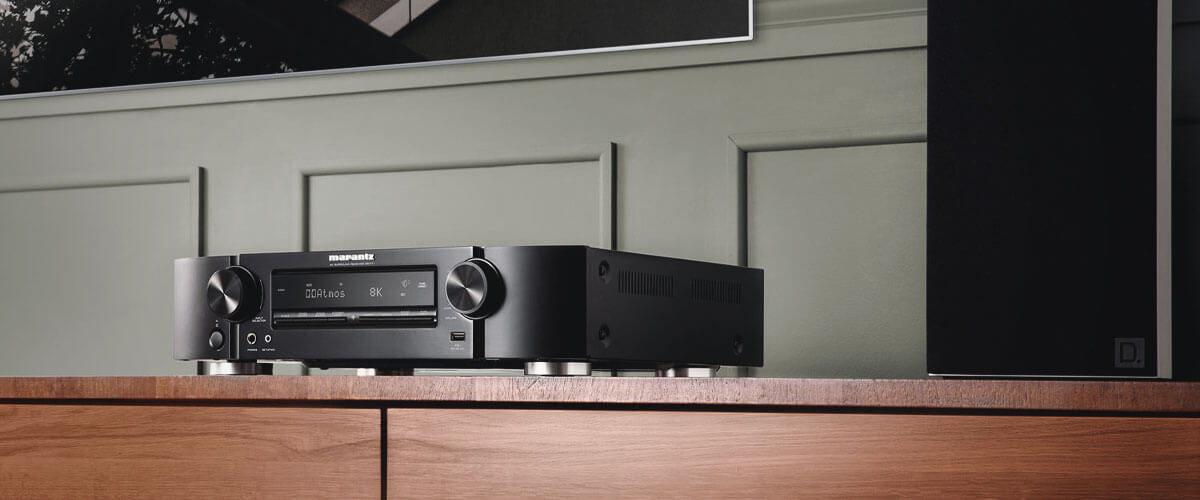
By the way, I liked the sound of the receiver during the test. I can’t say that it significantly differs from other devices in some special features (like DTS:X Pro or Auro 3D), but the music plays cleanly and dynamically. Even when listening to your favorite songs at high volume levels, you won’t feel any discomfort from distortion. In addition to Dolby Atmos, it also supports most modern audio formats and is equipped with Audyssey MultEQ technology.
In my opinion, the Marantz NR1711 is a good choice for movie and game lovers. Thanks to this device, you will be impressed with the detailed picture with 8K resolution. Also, you can find the full 3D sound support and advanced features for gamers here. So, I strongly recommend that you familiarize yourself with this model.
Key specs
- Channels: 7.2.
- Power output: 50W/8 Ohm, 70W/6 Ohm.
- HDMI inputs/outputs: 6/1.
- Video functions: 8K/60Hz, 4K/120Hz, 4K/60Hz.
- Bluetooth/Wi-Fi: yes/yes.
- Streaming services: AirPlay 2, Pandora, Spotify, Napster, SiriusXM, TIDAL, Deezer, Qobuz, Amazon Music.
- Suppots: HDMI eARC, HDMI Upscaling up to 8K, Dolby Vision, HDR 10+.
- Surround sound: Dolby Atmos, Dolby Atmos Height Virtualization, Dolby TrueHD, Dolby Surround, DTS:X, DTS Virtual:X, DTS HD Master, DTS Neural:X, Multichannel Stereo.
Pros
- Slim body.
- There is an 8К Ultra HD resolution.
- Supports ALLM, VRR, and QFT technology.
- 2 multi-room zones.
- Full 3D audio is available.
Cons
- Almost all HDMI ports version 2.0.
- Only one HDMI output.
Discontinued Marantz receivers
Marantz SR6015
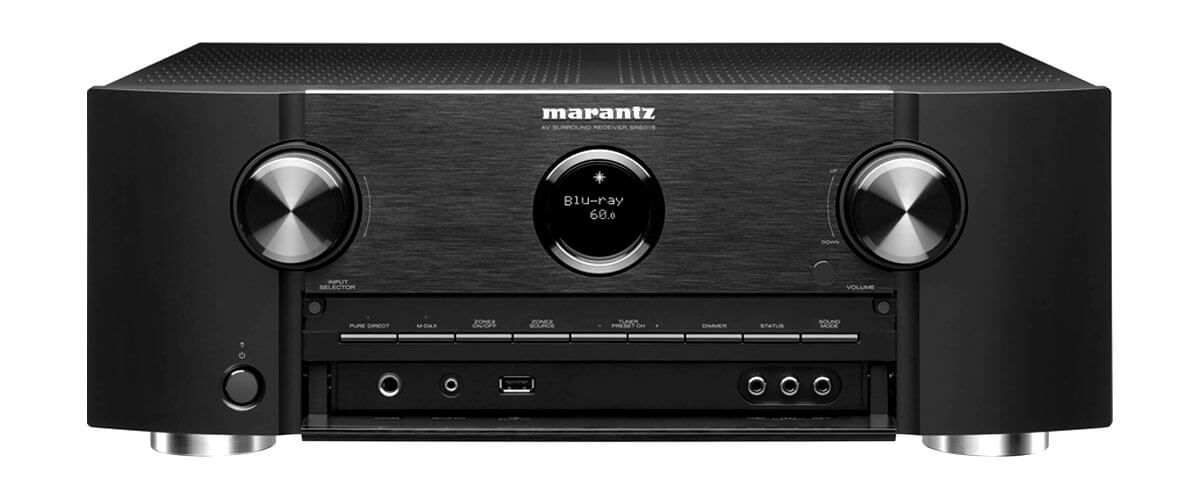
Well, I’ll start with the Marantz SR6015. I think this is a decent receiver with a rich set of features, which has not lost its relevance today.
Firstly, the AV receiver has a powerful 9.2 channel amplifier with 110W per channel (8 ohms, 20Hz – 20kHz, THD: 0.08%). As you can see, this is quite a powerful product with good performance.
Secondly, the picture looks at a decent level. Of course, I’ve tested many features, but the quality of the image especially struck me. It looks bright, attractive, and detailed because the AVR supports 8K resolution at 60Hz and 4K resolution at 120Hz. It also has the latest HDR formats, including HDR10, HDR10+, HLG, Dynamic HDR, and Dolby Vision. And I’m sure you’ll love the fact that it supports IMAX technology.
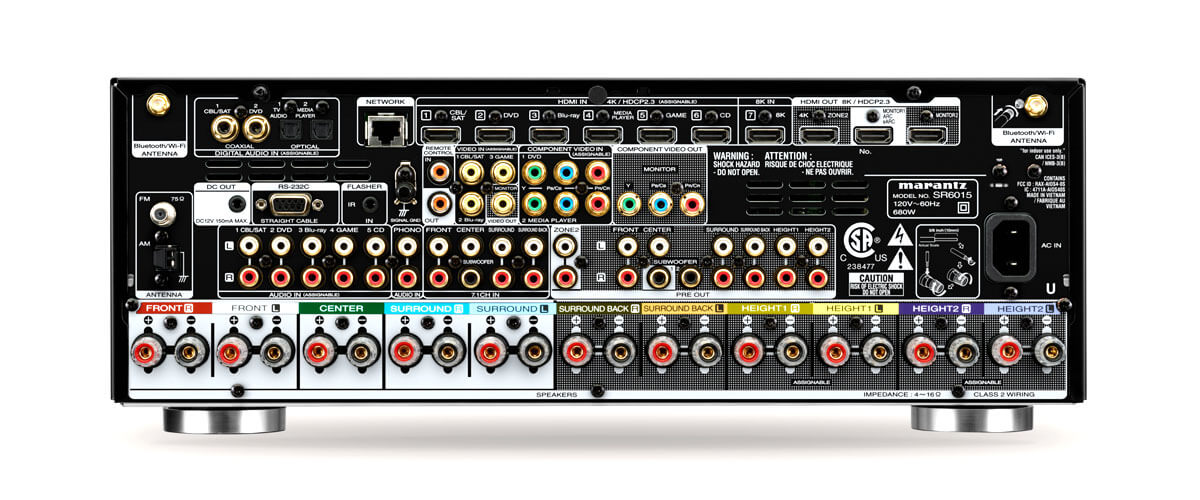
As for connectors and connection methods, there are a lot of options. For example, Marantz SR6015 has 7 HDMI inputs (all HDMI version 2.1) on the back panel and 3 HDMI outputs (HDCP 2.3 and Enhanced ARC support). Among the available connections, you will find two subwoofers out (independent), Ethernet Ports, Bluetooth, and Wi-Fi. Also, there are two multiroom zones.
The sound is excellent, but not perfect. I used the Audyssey MultEQ XT32 function for calibration. There was a noticeable distortion when I listened to music at high volume levels. But overall, it sounds dynamic and very clear. The SR6015 supports most modern surround sound formats: Dolby Atmos, DTS:X, DTS HD Master, DTS Neural:X, DTS Virtual:X, Dolby TrueHD, Dolby Atmos Height Virtualization, and Dolby Surround. But I was a little disappointed with the absence of DTS:X Pro and Auro 3D.
If you compare this model to the Marantz SR8015, the SR6015 is slightly inferior in almost all parameters. Besides, it doesn’t have Auro 3D and DTS:X Pro technology. In addition, there are two multi-room zones instead of three. But it is worth considering that the SR8015 is almost twice as expensive.
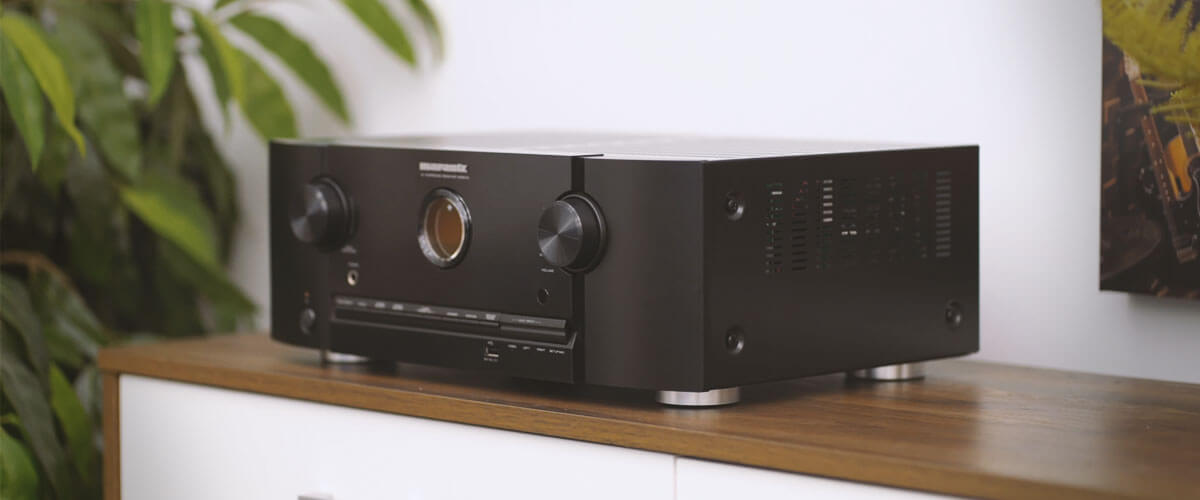
The SR6015 is an excellent receiver from Marantz, which has proven itself on the market. In addition, in my opinion, it has an almost optimal combination of price and quality. You get excellent surround sound quality, great picture, and versatility for a very reasonable price.
Key specs
- Channels: 9.2.
- Power output: 100W/8 Ohm, 150W/6 Ohm.
- HDMI inputs/outputs: 7/3.
- Video functions: 8K/60Hz, 4K/120Hz, 4K/60Hz.
- Bluetooth/Wi-Fi: yes/yes.
- Streaming services: AirPlay 2, Pandora, Spotify, Napster, SiriusXM, TIDAL, Deezer, Qobuz, Amazon Music.
- Suppots: HDMI eARC, HDMI Upscaling up to 8K, Dolby Vision, HDR 10+.
- Surround sound: Dolby Atmos, Dolby Atmos Height Virtualization, Dolby TrueHD, Dolby Surround, DTS Virtual:X, DTS HD Master, DTS Neural:X, Multichannel Stereo, IMAX Enhanced.
Pros
- Metal front panel.
- Two multi-room zones.
- Supports 8K pass-through.
- All 7 HDMI ports are version 2.1.
- IMAX Enhanced and Full 3D sound support.
- Easy sound calibration via Audyssey MultEQ XT32.
Cons
- No Auro 3D and DTS:X Pro.
Marantz receivers buying guide

Determine the number of channels you need
First, you must decide for what purpose you need the AVR. The point is that there is no reason to overpay for unnecessary or extra features of a receiver. It would help if you considered each channel as an opportunity to connect with a separate speaker. And so, if you see an 11.2 channel AVR, it means the receiver can power 11 speakers. The second figure denotes the number of subwoofers to which you can connect the device.
If you have a small room, buying an AVR with a large number of channels and support for different surround sound formats does not make sense. You only reduce the space of a small room by having a lot of speakers and wires. Therefore, the 5-channel receiver would be the better choice. But suppose you need a device for playing content in a huge house, while the critical factor for you is quality surround sound. In that case, the priority should be 7-channel receivers and above.
Determine the amount of power needed for your room
You should know that receiver power is expressed in Watts per channel. That is, how much energy the amplifier can provide to the speakers on each output channel.
The more the device’s capacity is, the better it will reproduce the sound without distortion. And that is why it is essential to have additional power.
To determine how much energy you need for the room, you have to ask yourself the following question: “How big is your room where you plan to install the Marantz home theater system?” If you have a room of less than 30 square meters, a device with a power of about 50-75W is more suitable for you. You need to buy powerful receivers (from 100W and more) for larger rooms. I prefer an AVR with about 100W per channel. Thus, you get a versatile product for small and medium-sized spaces.
Number of HDMI and other connections
As for the number of HDMI ports and connection methods, you have to create a list to make the right decision. It should include everything you will use now, and probably in the near future (for example, game consoles, TV, and others). As practice shows, there are not enough ports. That is why I recommend choosing a device with at least 6 HDMI inputs.
Also, it is worth noting that there are different versions of HDMI. A better solution is to use port version 2.1. That way, you can achieve faster throughput, providing excellent sound and picture quality. So this is an essential point to which you should pay attention.
Standard connection methods include a subwoofer, Wi-Fi, Ethernet ports, and Bluetooth. I want to highlight such technology as Wi-Fi. I believe that all modern receivers should support it
4K, 8K support and HDR formats
Support for 4K resolution will suit many users in most cases. With it, you may get a pleasant experience while watching TV. The difference between 4K and 8K is hardly noticeable. But if you have a TV with a screen size of 60 inches or bigger, you should make a choice in favor of an 8K pass-through.
What is an HDR (High Dynamic Range) format? It is a television standard that provides a high-quality picture with excellent color reproduction and better contrast than conventional sets. Thanks to it, you can enjoy a quality image while watching video content. You can also find several HDR types, such as HDR10, HDR10+, Advanced HDR, Dolby Vision, and HLG. Of course, they have some differences, but these are technical aspects. Ideally, if your receiver supports most new formats, you will be able to get a wonderful feeling from watching.
The presence of HDCP 2.2 or HDCP 2.3 is also important. It is a certificate of copy protection. Every year, more and more video content is created using this method. How does it work? It’s simple. If you want to watch a movie that uses this technology, but your AVR does not support HDCP 2.2, the TV screen will go dark.
Wi-Fi, Bluetooth, multiroom audio
As for multiroom audio, then all is not so simple. Of course, some people will agree with me that such a feature is handy. But others may not need it at all. That’s why I recommend you decide on the functionality from the very beginning because you will have to pay some extra money for this feature.
If you decide that you can not do without it, you should consider the number of multi-room zones. Thanks to them, your family can listen to and watch various content in different rooms of the house.
It is also worth checking for Wi-Fi and Bluetooth support. Their presence will allow you to comfortably connect and control the speakers through your phone. It simply makes no sense to buy a receiver without support for these functions to date.
Surround sound formats capability
Let’s start with the fact that if you want to get good emotions from surround sound, one receiver alone will not be enough, although much depends on it. First of all, you need to build a quality home theater with a certain number of speakers. Also, you should calibrate the sound properly considering the characteristics of your room, where you plan to listen to music or watch your favorite movies.
Well, what about surround sound formats? There are several of them. Dolby Atmos and DTS:X are the most common in the medium price range. With their help, you can get good results. The newer formats, such as Auro 3D and DTS:X Pro, allow you to improve quality, bringing a new level.
By the way, let me give you a little advice. To get quality surround sound, choose at least a 7-channel device. That way, you can use more speakers, which will certainly improve the sound.

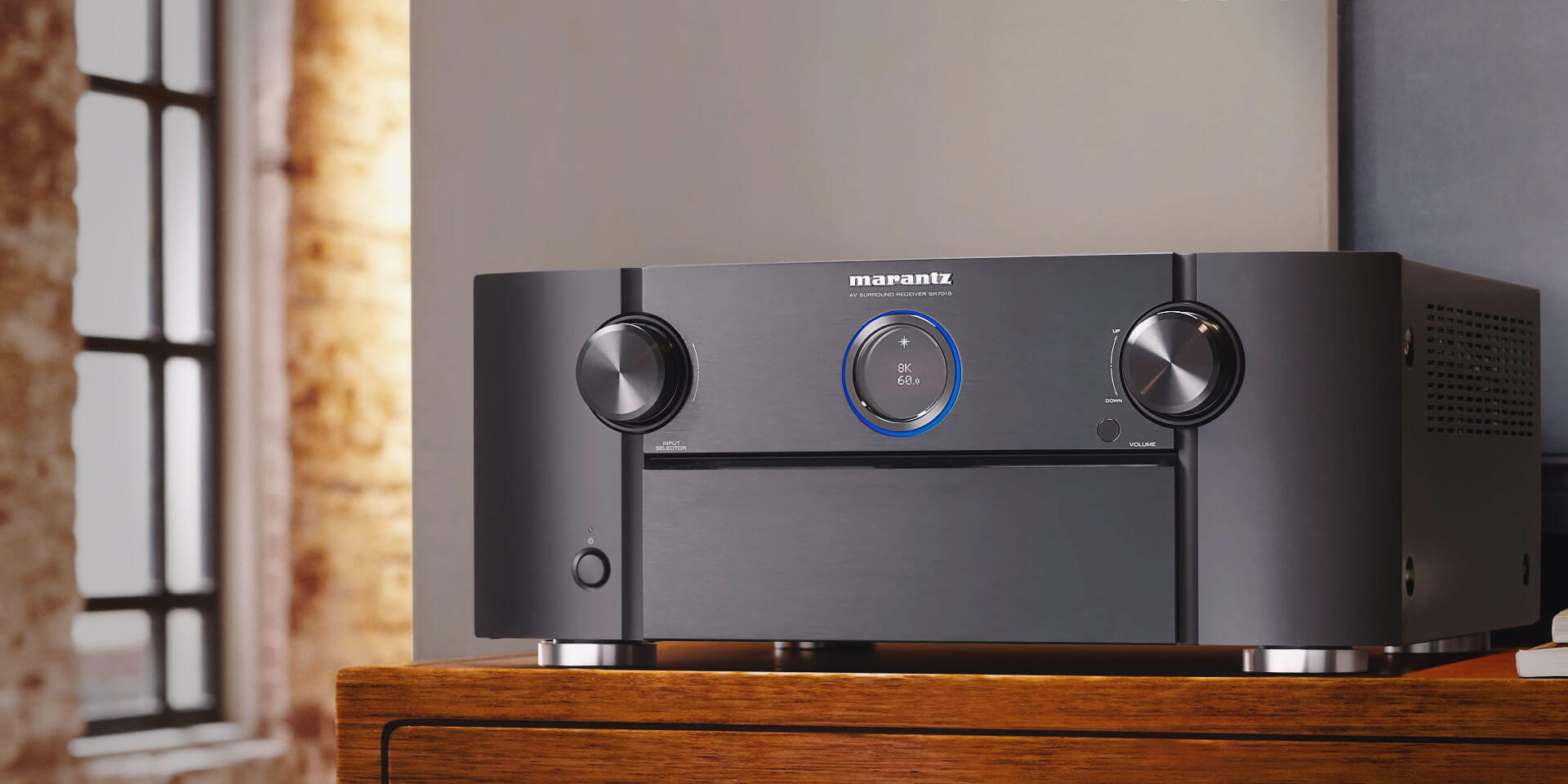


![Best 2-Channel Receiver [Expert Reviews and Buying Guide]](https://hometheaterology.com/wp-content/uploads/2023/11/best-2-channel-receiver-stereo-300x150.jpg)


